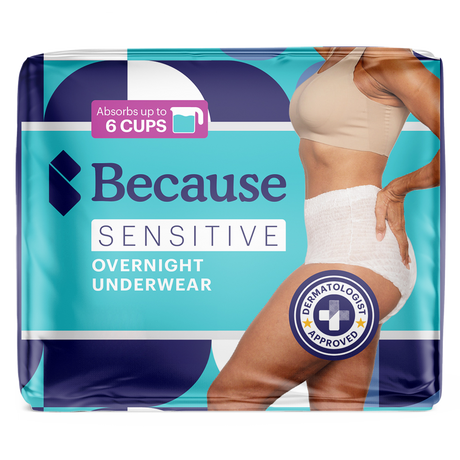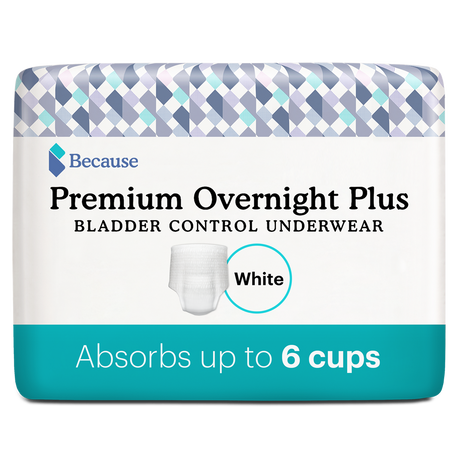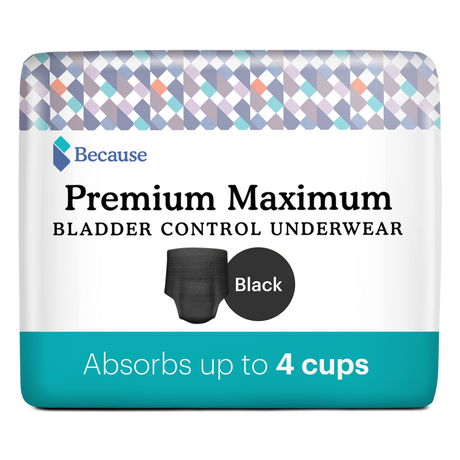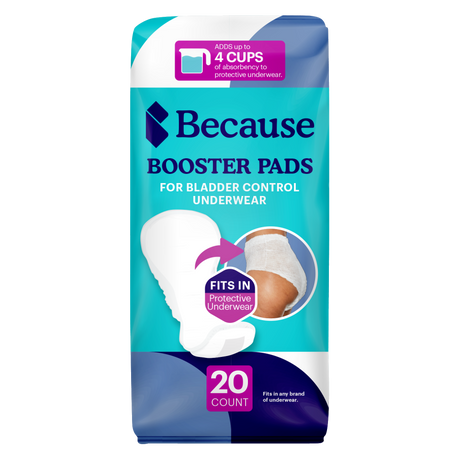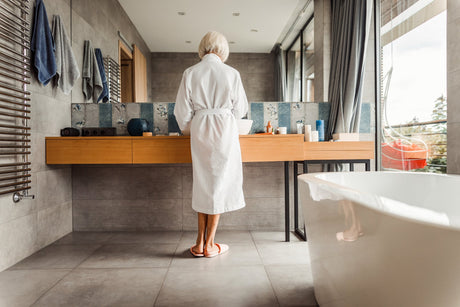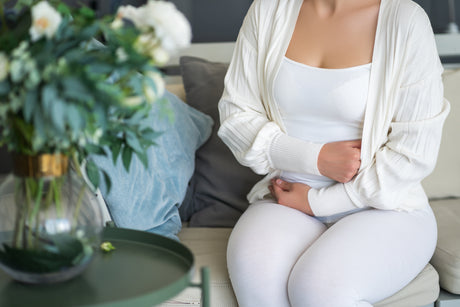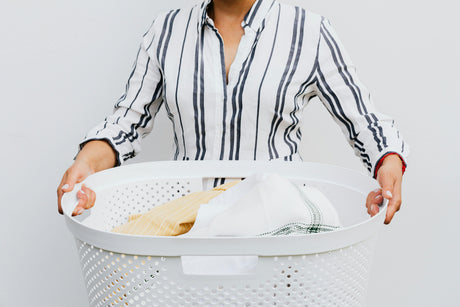Being a caregiver can be an emotional and taxing role in life. And when you add caretaking for someone with incontinence, the situation can become even more stressful. But incontinence care for the elderly doesn’t have to rule your life and schedule. Through open communication, the right products and tools, and a better understanding of this condition, it will become easier to figure out how to deal with elderly incontinence and offer the best elderly incontinence care you can.
Is Incontinence a Normal Part of Aging?
Yes, millions of older adults across the country struggle with incontinence. In fact, urinary incontinence affects 25 million people in the US and half of women over 50. Incontinence is generally caused by weak pelvic floor muscles which aren’t properly supporting organs and muscles like the bladder and bowels. As we age, these muscles often lose strength and elasticity. However, while it is common, according to pelvic floor specialists, it’s not necessarily normal in many cases. With pelvic floor exercises called kegels, many people see improvement in incontinence symptoms.
Common Causes of Elderly Incontinence
There are a number of common causes of incontinence in the elderly. While weakened pelvic muscles are a major contributing factor, as mentioned above, certain health conditions, lifestyle habits, and medications can cause or exacerbate incontinence in an elderly person. Below, we’ll outline some of those most common causes of elderly incontinence.
Cognitive, Mobility, or Sensory Limitations
When an elderly person is dealing with diseases such as Alzheimer's disease, dementia, Parkinson’s disease, multiple sclerosis, or autism, incontinence is much more common due to the physical and mental limitations of those diseases. These and other cognitive, mobility, and sensory limitations can result in incontinent episodes due to inability to access a bathroom on their own, involuntary bodily movements, or confusion of their body’s needs.

Health Conditions
Diabetes causes an increase in urine production, and in elderly people that often leads to a struggle with incontinence. Other health conditions, like arthritis or poor eyesight, simply inhibit a person from being able to access a toilet when they need it. Wearing clothing that’s easy to remove, as well as having pathways to a bathroom being clear and well-lit can help minimize accidents when a person is en route to the bathroom. Health conditions like a urinary tract infection (UTI) can also result in incontinence. Since a UTI causes irritation in the bladder lining, more frequent urination generally occurs. If unprepared, a person could more likely experience bladder leaks or accidents.
Medications
Certain medications have side effects that impact the body’s ability to detect when the bladder is full, which can easily lead to accidents. Many people taking sedative medications encounter this, while medications like antidepressants can interrupt bladder function.
Excess Weight
Obesity is linked with a higher risk of developing urinary incontinence. Excess weight can put pressure on the bladder, which weakens your pelvic floor muscles over time. This naturally results in anything from minor to major bladder leaks.
Smoking
A lifelong smoking habit or nicotine addiction can not only impact your overall health but specifically, nicotine can irritate the muscles in the bladder wall, resulting in urinary incontinence over time.
Constipation
Recurring or consistent constipation can result in a straining and fatigue of the pelvic floor muscles. In addition, a full bowel can put pressure on the bladder.
Types of Incontinence
There’s not just one type of incontinence. Not only are there several types of urinary incontinence, but many people also deal with bowel incontinence. We’ll dig into the details of the most common types of incontinence below.
Urge Incontinence
One of the more common types of incontinence, urge incontinence involves a person who notices the urge to use the bathroom, but can’t hold it in and make it to the bathroom in time. What’s happening in the body is that the bladder starts contracting when it’s not supposed to (or before it’s supposed to). For some, this just results in minor leaks before making it to the toilet. However, other people, once a leak begins, can’t stop an accident from escalating.
Stress Incontinence
Stress incontinence occurs as a result of unexpected pressure on the bladder. If you’ve ever experienced a small bladder leak after a sneeze, cough, or lifting a heavy object, you’ve experienced a form of stress incontinence.
Overflow Incontinence
You’ll know you’re dealing with overflow incontinence if you feel like you’re unable to fully empty your bladder when using the bathroom. This is most common in men with enlarged prostate glands, as an enlarged prostate can block the urethra and prevent it from being able to void all of the urine in the bladder. The result of this is that the bladder gets overfull, and urine leaks out between trips to the bathroom.
Bowel Incontinence
Bowel incontinence (also known as fecal incontinence) plagues over 5.5 million adults in the U.S. and occurs when a person is unable to control their bowel movements. For some, it’s minor and episodes are occasional and minor, caused when a person sneezes or passes gas. Others experience more frequent leaks or larger uncontrolled bowel movements.
How to Deal with Elderly Incontinence
Being a caretaker for someone with incontinence is no small thing. Emotionally, it requires empathy, patience, grace, and sometimes even a good sense of humor. Of course, it also requires frequent changes and cleanup, which can feel embarrassing to both you and the person for whom you care.

Be Empathetic
Empathy goes a long way in elderly incontinence care. Likely, your loved one or patient feels embarrassed or frustrated with their own limitations—so adding your own heightened emotions won’t help the situation. Rather, enter into conversations about incontinence or accident cleanup with an attitude of empathy, kindness, and generosity, considering what it must feel like to be on the other end of the situation. (They’re probably feeling a significant loss of dignity!) Empathy will help you have compassion toward your loved one when dealing with incontinence.
If you’re struggling with your role as a caregiver or specifically with elderly incontinence care, consider starting a caregiver journal or exploring other forms of self-care to help manage your stress levels.
Adopt a Matter-of-Fact Approach
Being overly emotional or reactive when it comes to accidents won’t help you or the older adults for whom you care. It can be quite helpful to, instead, adopt a matter-of-fact approach when dealing with incontinent episodes, and even in the way you communicate with your loved one about incontinence. Urination and bowel movements are a fact of life, and as a caretaker you can simply treat them as such. (Remember the kid’s book “Everybody Poops”?) This matter-of-fact approach can also help alleviate any embarrassment your loved one feels around incontinent episodes.
Always Be Prepared for Accidents
Adjusting your expectations and assuming accidents will happen can help reframe your mindset on this area of caregiving. By expecting and being prepared for accidents, it will be easier to take them into stride and deal with them without it deeply impacting your day. If you have the supplies you need to clean up and change after an accident, you can more quickly and easily move on with your day.
This is especially important when leaving the house with someone dealing with incontinence. Be sure to pack a backpack or small tote bag filled with everything you need to clean up on-the-go, like spare bladder protection products, disposable bags, wipes, gloves, and hand sanitizer.
Choose the Right Incontinence Products
So, what are the right products that can simplify regular changes and make clean-up more streamlined? First, it’s helpful to assess the absorbency level your loved one needs in their bladder protection products. Are they just dealing with small leaks? Pads or guards may be all they need. Do they have occasional episodes where they void their whole bladder? Bladder protection underwear with an advanced absorption core and leak guards may be a better fit. If they have frequent, significant episodes, or more accidents at night, consider overnight underwear, which absorbs up to six cups of liquid. You could also add boosters inside of their bladder protection underwear, which offers an additional four cups of absorption to help prevent leaks. (Need help with sizing? Check out our size chart.)
And, to make cleanup more simple, invest in extra-large flushable cleansing wipes and/or no-rinse cleansing spray to make clean-up a breeze. We also highly recommend barrier cream, which prevents and heals irritation caused by incontinence or wearing bladder protection products, including adult diaper rash.
Managing Elderly Incontinence
Aside from your mentality and having the right products on-hand, there are several tips that can help when it comes to incontinence care for the elderly to improve you and your loved one’s quality of life and stress levels.
Kegels and Pelvic Floor Exercises
If it’s physically possible, have your loved one practice a type of pelvic floor exercises called kegels. As mentioned at the beginning of the post, these exercises can strengthen the pelvic floor and help minimize bladder leaks. Learn more about kegel exercises and how to do them.
Timed Voiding
It can be helpful to create a bathroom schedule (perhaps every two hours) so that your loved one knows exactly when to expect a trip to the bathroom. This not only helps their active brain to have proper expectations of when they’ll be able to use the bathroom, but also helps signal their brain on a subconscious level to wait for that bathroom trip before activating bladder muscles. It may take some time and practice, but if you keep a schedule of bringing them to the bathroom, overtime they may experience fewer accidents.
Healthy Lifestyle Changes
Certain lifestyle changes can help improve symptoms of incontinence and improve quality of life. Reducing caffeine by limiting coffee and tea intake can help with incontinence, as caffeine is a stimulant that activates the bladder. Reducing alcohol, which can act as a diuretic, is a good idea and can also have a positive impact on urinary incontinence.
Address Constipation Issues
As mentioned earlier, ongoing constipation is a contributing factor for developing urinary incontinence. Incorporate more fibrous foods into your diet to help reduce constipation. If constipation continues, seek help from your doctor or a nutritionist.
Adapt the Home Environment
By making minor changes to the home in which you live, you may be able to minimize incontinent episodes. Sometimes, an older adult knows they have to go to the bathroom but can’t make it in time either because they’re too far away from the bathroom or they encounter obstacles along the way. By clearing a path to the bathroom and ensuring resting places are close enough to a bathroom, you may be able to minimize accidents.
Fluid and Diet Management
It’s important to limit drinks in the evening in anticipation of overnights. This will reduce the need for multiple trips to the bathroom at night or the unpleasant accidents that can occur while a person is sleeping. You should also pay attention to any food that’s irritating to a person’s digestive system (like spicy foods), as that can cause unexpected accidents. Reducing or eliminating irritating foods can have a positive impact both on incontinence symptoms and overall well-being.
Skin Care and Hygiene
When dealing with incontinence, a good skincare routine is essential. By regularly cleansing, protecting, and moisturizing the skin that comes in contact with bladder protection products, you’ll keep skin healthy and your loved one more comfortable.
Odor Control
It’s also helpful to consider odor control, especially when dealing with bowel incontinence. Proper cleanup between episodes, as well as proper disposal, will minimize odors and keep both the elderly person in your care and their home environment feeling and smelling clean.

Coping with Elderly Incontinence at Night
Many elderly incontinent patients particularly struggle with bladder and bowel control at nighttime. Some have accidents when sleeping, while others simply cannot get out of bed and make it to the bathroom in time, or aren’t physically able to get to the bathroom themselves. If this is the case, it’s essential to invest in the best nighttime incontinence products. Start with overnight protective underwear, which offer the highest levels of absorption (up to six cups of liquid!). Adding boosters, which are designed to be used in tandem with protective underwear, can give you additional absorption and leak protection. You should also try bed protectors, which can be placed between a person and their sheets/mattress to offer additional waterproof protection and easier cleanup if leaks occur.
When to See a Doctor
If you feel like bladder or bowel leaks are out of control and overtaking your schedule, seek help from a doctor. After completing a physical examination and getting context around the issue, they can refer you to a urologist, gastroenterologist, or pelvic floor therapist to see what else might be going on and help you find treatment options. There’s no need to feel totally overwhelmed when it comes to incontinence, and talking to your doctor can help offer guidance, get answers, and alleviate stress for both you and your loved one.
Does your loved one struggle with incontinence? Take our bladder protection quiz and get a sample pack to try.

